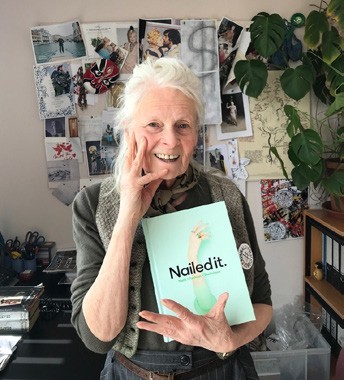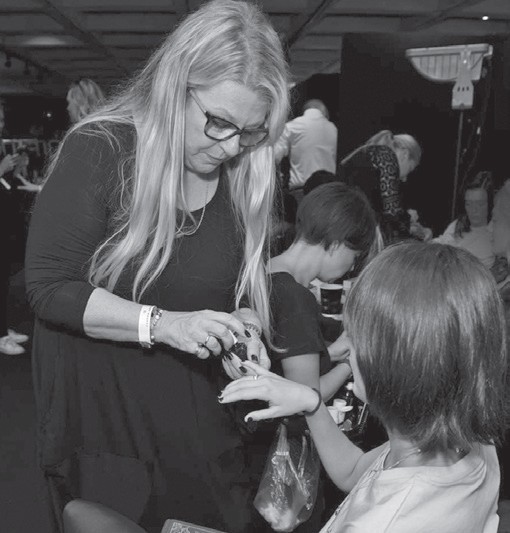MARIAN Newman
The renowned session tech and nail industry expert tells Eve Oxberry about her rise to the top, and an exciting new education project due to launch later this year
Talking to…
Best known as the original session tech, Marian Newman carved a path for nail artists in the worlds of fashion, editorial and advertising back in the ‘90s. But, as a former forensic scientist and a qualified teacher, it’s the technical and scientific side of the nail industry where her passion lies. As such, it’s her knowledge, just as much as her skills with a brush, that have kept her profile strong in the years since.
It’s that same passion that has led her to work on an exciting new project during the coronavirus lockdown period, focused on improving nail education. “Education is a major problem in the industry because there are so many short courses and online courses that spend too much time on the pretty stuff without teaching the basics,” says Newman. “I’m amazed by the number of nail professionals who don’t even understand the structure of the nail unit. They can’t name the parts. They don’t know where the matrix is, and they don’t know what the bed epithelium is or the part it plays, and that is vital.”
Her new project, The Essential Nail Professional, aims to change all that by introducing a different way of learning that is more accessible to the creative types of people that often enter the industry. “I’ve written textbooks since 2000 but textbooks, for creative people, are hard to read because not everybody learns by reading words,” she says. “I’ve done a lot of study on the psychology of teaching and how important learning styles are, and textbooks are great but they don’t work for everybody”.
Deeper understanding
Instead, The Essential Nail Professional, which is set to launch toward the end of this year, will focus on teaching core theory in a more engaging way. “I can’t tell you exactly how it works until we launch but it’s going to free up the teachers so that they can spend more time on the one-to-one physical learning , even in a group, because as a teacher you need to really watch your students and how they do everything,” she says. “It’s got nothing to do with application though, it’s all to do with knowledge, theory and understanding – but understanding deeply. There are a lot of online courses that teach you theory but often that’s just reading words and seeing a diagram; this is a million miles away from that and I’m really excited.” Right from the start, Newman’s career was borne out of this commitment to training and standards, as it was her role working with industry associations in the ’90s and creating standards that lead to her first session job.
Ticket to the top
Having retrained in nails in the ‘80s, Newman quickly became very active with the International Nail Association and with the Hair and Beauty Therapy Training Board (which later became Habia) helping to write the national occupational standards for many years. Then, one day, the association had a call from a photographer who wanted someone to do some nails for a shoe advertising campaign. “This was unheard of in 1996, but I said, ‘yeah, that sounds interesting’, so I took a tiny kit along and there was no hair or make-up there, just me. I had to match the colour of the nails exactly to the colour of these shoes,” she says. “I didn’t have a clue who I was working with but later discovered the photographer was Nick Knight, who is one of the most amazing and genius photographers in the world, and the stylist was Lucinda Chambers, the then fashion director of British Vogue. And that was that, really – about month later, I did my first Vogue cover with Kate Moss.”
While such a fast rise to the top may be unheard of in today’s competitive nails world, Newman says there are definite advantages to working in a more established market.
“Techs don’t walk into a shoot or a video and get looked up and down like I used to and asked, ‘What do you mean you only do nails?’ It’s accepted now. I’m proud that every single shoot, fashion show or editorial that has hands or feet anywhere near it will always have a manicurist or a nail technician there because the beauty industry is so important.”
There are so many short courses and online courses now that spend too much time on the pretty stuff without teaching the basics… and that is vital

Newman’s nail art; Vivienne Westwood reading Nailed It; with make-up artist Dominic Skinner; her work with British Beauty Council

Newman’s nail art; working backstage for Roland Mouret; her coffee table book Nailed It (image: paintbucketnails/ Instagram)
Lessons learned
However, as most session techs are at pains to point out – the work is far from glamorous. “You’ve got to fight for your place on the model, scrabbling around on floors,” says Newman, advising any techs who want to break into session work that “you’ve also got to be able to deal with a creative team and all of the egos that come with it. And not talk too much; we’re used to working in salons where you almost have to entertain your clients but when you’re in a studio, your client is a model or a celebrity and everybody else wants to get their conversation in as well.”
However, while it may be vital to put in the graft to make your name, Newman says that if there is one piece of advice she could give her younger self it would be “look after your health and your posture”. She adds. “I know through all those years of doing session work that I wasn’t looking after my physical health. Since I’ve got older, I’m suffering from it. I’ve had five slipped disks and that’s all from sitting badly and from carrying heavy stuff on my shoulder rather than using a trolley. So that and getting the best education possible are probably the two most important things.”
Favourite moments
Looking back on such a diverse career, Newman says it’s impossible to pick a highlight. “I loved seeing my first textbook come out; holding it and thinking ‘I wrote that!’, she says. “But some of the people that I’ve worked with have given me real ‘pinch me’ moments too, like when I did Brad Pitt’s nails. I was giving him a hand massage and looking up into his face and thought ‘wow’, so silly things like that have been pretty amazing.”